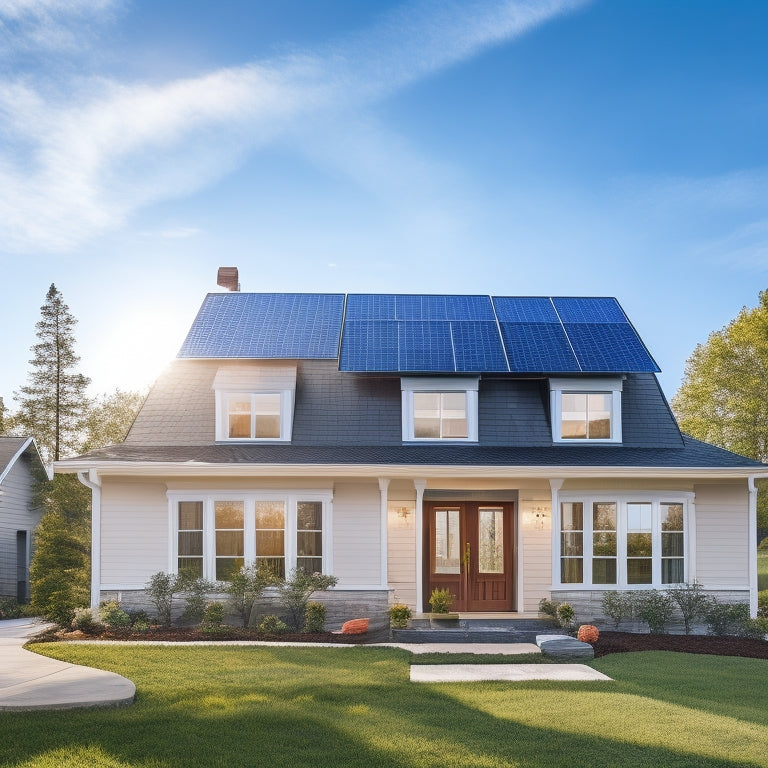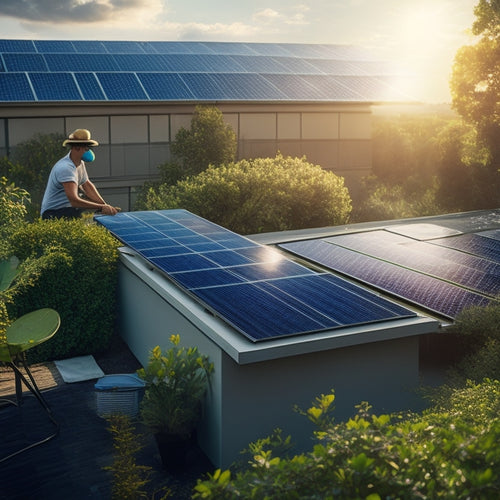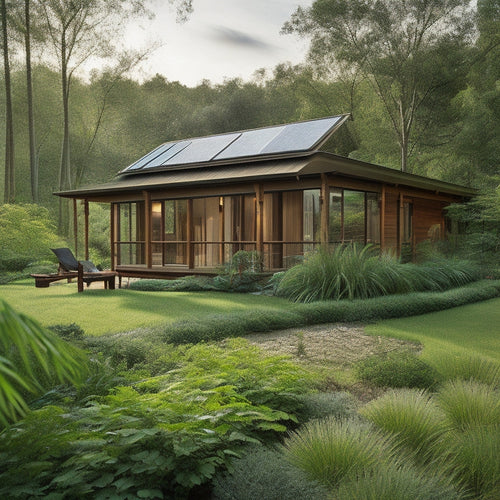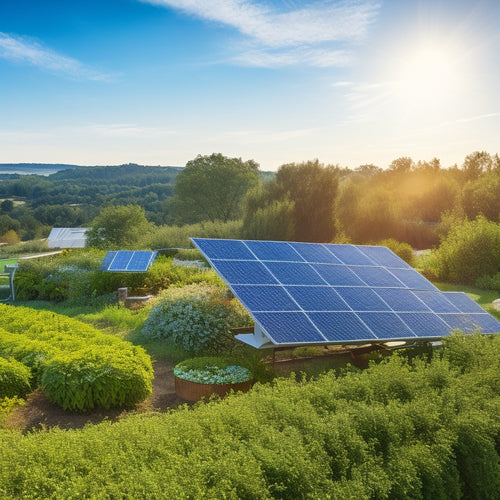
What Are the Cheapest Low Cost Solar Panels for Your Home
Share
When looking for the cheapest low-cost solar panels for your home, you'll want to evaluate top brands like Trina, Hanwha Q CELLS, and Jinko Solar, which offer quality and cost-effectiveness. You can also investigate different types of cost-effective solar panels, such as monocrystalline, polycrystalline, thin-film, and bifacial panels, which vary in efficiency and price. To determine the best option for you, assess your energy usage, budget, and available roof space. By assessing your needs and options, you'll be able to find the most affordable solution for your home - and learning more about the benefits and installation process can help you make an informed decision that's right for you.
Key Takeaways
- Trina, Hanwha Q CELLS, and Jinko Solar offer affordable and reliable solar panel solutions with high-efficiency cells and durable designs.
- Polycrystalline solar panels provide a cost-effective option with 12-15% efficiency at $2.00-$3.00 per watt.
- Thin-film solar panels are the most budget-friendly option with 7-14% efficiency at $1.50-$2.50 per watt.
- Bifacial solar panels offer high efficiency at 18-22% but at a higher cost of $3.00-$4.00 per watt.
- PERC solar panels offer a balance of efficiency and cost with 18-22% efficiency at $2.50-$3.50 per watt.
Top Brands for Affordable Solar
Investigate the market for affordable solar panels and you'll find a plethora of options from top brands that offer quality and cost-effectiveness.
When searching for budget solar options, you'll come across renowned brands like Trina, Hanwha Q CELLS, and Jinko Solar, which provide reliable and efficient solar panels at competitive prices. These brands offer a range of affordable energy solutions that cater to different needs and budgets.
Trina's Honey M Series, for instance, boasts high-efficiency cells and a durable design, making it an attractive option for homeowners seeking reliable performance at an affordable price.
Hanwha Q CELLS' Q.PEAK series, on the other hand, offers high-power output and excellent low-light performance, making it suitable for households with varying energy demands.
Jinko Solar's Cheetah series, meanwhile, features advanced technology and a sleek design, providing homeowners with a budget-friendly option that doesn't compromise on performance.
Cost-Effective Solar Panel Types
Your solar panel search doesn't have to break the bank. You can find cost-effective options that still provide efficient energy harvesting. When it comes to cost-effective solar panel types, you have two main options: monocrystalline panels and polycrystalline panels.
| Panel Type | Efficiency | Cost |
|---|---|---|
| Monocrystalline | 15-20% | $2.50-$3.50 per watt |
| Polycrystalline | 12-15% | $2.00-$3.00 per watt |
| Thin-Film | 7-14% | $1.50-$2.50 per watt |
| Bifacial | 18-22% | $3.00-$4.00 per watt |
| PERC | 18-22% | $2.50-$3.50 per watt |
Monocrystalline panels are made from a single crystal structure, making them more efficient but also more expensive. Polycrystalline panels, on the other hand, are made from multiple crystal structures, making them less efficient but more affordable. While they may not be as efficient, polycrystalline panels are a great option for those on a budget. Ultimately, the choice between these two options depends on your energy needs and budget.
Benefits of Low-Cost Solar Energy
Access to affordable solar energy solutions can be a game-changing factor for individuals and communities worldwide. As you consider investing in low-cost solar panels, it's crucial to understand the benefits that come with utilizing solar energy.
One notable advantage is the reduced environmental impact. By switching to solar power, you'll greatly decrease your reliance on fossil fuels, leading to a considerable reduction in greenhouse gas emissions and air pollution. This, in turn, contributes to a cleaner and healthier environment for you and your community.
Another vital benefit is the long-term savings you'll enjoy. While the initial investment in solar panels might seem substantial, the cost of solar energy is much lower than traditional energy sources in the long run.
With low-cost solar panels, you can lock in a fixed energy rate, protecting you from rising electricity prices. This means you'll save money on your energy bills, which can add up to considerable savings over time.
How to Calculate Solar Savings
You'll need to contemplate two key factors to calculate your solar savings: your current solar energy costs and the reduction in your energy bill.
To get an accurate estimate, you'll want to analyze your past energy bills to determine your average energy usage and cost.
Solar Energy Costs
Calculating the costs and savings of solar energy is crucial for understanding its economic benefits. As you evaluate investing in solar panels, it's important to understand the upfront costs and long-term savings.
Solar pricing trends show a decline in installation expenses over the years, making solar energy more affordable.
When calculating solar energy costs, you'll need to take into account the initial investment, including the cost of the solar panels, inverters, and installation. The average cost of a solar panel system ranges from $15,000 to $30,000.
However, federal and state incentives, such as tax credits, can greatly reduce the upfront cost. Additionally, many solar panel manufacturers offer financing options or power purchase agreements to make solar energy more accessible.
To calculate your solar savings, you'll need to ascertain how much electricity your solar panel system will generate and the amount of money you'll save on your utility bills.
Energy Bill Reduction
As you contemplate investing in solar energy, understanding how to calculate your solar savings is crucial for determining the return on your investment.
You'll want to assess your current energy consumption and identify areas where solar energy can make a significant impact. Start by reviewing your past energy bills to determine your average monthly energy consumption. This will give you a baseline to compare your future energy bills with.
Next, calculate the amount of energy your solar panel system is expected to produce. You can use online tools or consult with a solar panel professional to determine the estimated energy output of your system.
Once you have this information, you can subtract the estimated energy production from your average monthly energy consumption. This will give you an idea of how much you can expect to save on your energy bills each month.
When budget planning, it's crucial to take into account the upfront cost of the solar panel system, as well as any financing options or incentives that may be available.
Solar Panel Efficiency Ratings
Solar panels convert sunlight into electrical energy with varying degrees of efficiency, and understanding these ratings is essential when selecting the best low-cost option for your needs.
Efficiency ratings, typically ranging from 15% to 22%, indicate how much of the sun's energy is converted into usable electricity. You'll find that different solar panel types have distinct efficiency profiles.
For instance, monocrystalline silicon panels generally boast higher efficiencies (18-22%) compared to polycrystalline silicon panels (15-18%). Thin-film panels, on the other hand, have lower efficiencies (7-14%).
When comparing efficiencies, consider your available roof space and energy requirements. If you have limited space, higher-efficiency panels might be the better choice. However, if you have ample space, lower-efficiency panels at a lower cost might be more suitable.
Low-Cost Installation Options
By the time you've selected the ideal solar panels for your needs, you'll still need to contemplate the installation process, which can considerably impact the overall cost.
Fortunately, there are ways to reduce installation costs without compromising on quality.
To minimize expenses, consider the following low-cost installation options:
-
Local installers: Partner with local installers who can provide budget-friendly services, reducing transportation costs and ensuring timely project completion.
-
Pre-fabricated systems: Opt for pre-fabricated systems that come with pre-assembled components, reducing labor costs and installation time.
-
Energy storage bundles: Purchase energy storage bundles that include solar panels, inverters, and batteries, often at a lower cost than buying individual components.
- Group purchasing programs: Join group purchasing programs that allow you to buy solar panels and installation services at a discounted rate, leveraging the collective buying power of your community.
DIY Solar Panel Installation
When you decide to install solar panels yourself, you'll need to start by evaluating your site to guarantee it's suitable for solar energy.
You'll also need to gather the necessary tools and materials, which may include a drill, roof hooks, and wiring.
Before you begin, make certain you take essential safety precautions to avoid injuries and secure a successful installation.
Site Assessment Needed
You're about to take the first vital step in your DIY solar panel installation expedition: conducting a site assessment. This pivotal step helps you determine whether your home is suitable for solar panels and guarantees you get the most out of your investment.
During the site evaluation, you'll need to take into account the following factors:
-
Roof orientation: Is your roof facing south, west, or east? A south-facing roof receives the most sunlight, making it ideal for solar panels.
-
Shading: Are there any obstacles, such as trees or buildings, that could cast a shadow on your solar panels?
-
Roof size and condition: Is your roof large enough to accommodate the solar panels, and is it in good condition to support their weight?
- Local building codes and regulations: Are there any local regulations or restrictions that might affect your solar panel installation?
Tools and Materials
Now that you've completed the site assessment, it's important to gather the necessary tools and materials for your DIY solar panel installation. You'll need a range of solar panel tools, including a drill press, wire strippers, and a multimeter to guarantee accurate electrical measurements.
Additionally, you'll require installation materials such as mounting hardware, flashing, and sealants to secure the panels to your roof.
For the panels themselves, you'll need to purchase low-cost solar panels that meet your energy requirements. Consider the wattage, voltage, and ampere rating of each panel to verify they're compatible with your system.
Don't forget to acquire the necessary inverters, charge controllers, and batteries for energy storage and conversion.
Be certain to source high-quality materials that meet industry standards for durability and performance. While it's crucial to keep costs low, compromising on quality may compromise the entire system's efficiency and lifespan.
With the right tools and materials, you'll be well on your way to a successful DIY solar panel installation.
Safety Precautions First
Installing DIY solar panels requires careful attention to safety protocols to prevent accidents and guarantee a successful project. You must prioritize your safety and the safety of others involved in the installation process.
Failure to do so can result in serious injuries, electrical shocks, or even fatalities.
To ascertain a safe and successful installation, follow these essential safety precautions:
-
Wear appropriate safety equipment, including gloves, safety glasses, and a hard hat, to protect yourself from physical harm and electrical shock.
-
Verify a secure and stable ladder or scaffolding system to access the roof, and always maintain three points of contact (two hands and one foot, or two feet and one hand).
-
Confirm that the electrical disconnect is switched off before starting the installation, and use a voltage tester to confirm the absence of electrical power.
- Follow the manufacturer's installation guidelines and local building codes to avoid any potential hazards or code violations.
Government Incentives for Solar
Since the cost of solar panels has decreased over the years, governments around the world have introduced various incentives to encourage homeowners and businesses to adopt solar energy.
As you consider investing in solar panels for your home, it's crucial to investigate the government incentives available to you. In the United States, for instance, you're eligible for federal tax credits, which can greatly reduce your tax liability. These credits can cover up to 26% of the total cost of your solar panel system.
Additionally, many states offer rebates, which can further lower the upfront cost of your investment. You'll also want to look into state-specific incentives, such as net metering laws, which allow you to sell excess energy back to the grid and offset your utility bills.
Some states even offer property tax exemptions or sales tax exemptions for solar panel systems. By taking advantage of these government incentives, you can greatly reduce the cost of going solar and start generating clean energy for your home sooner.
Cheap Solar Panels for Sale
While exploring government incentives is crucial, finding affordable solar panels is equally important to making the shift to clean energy. As you traverse the market, you'll want to reflect on budget solar options that fit your needs and wallet.
When searching for cheap solar panels for sale, you're likely to come across various affordable options. Here are a few to ponder:
-
Tier 1 panels: These high-efficiency panels from well-known manufacturers like Trina and Jinko offer a balance of quality and affordability.
-
Tier 2 panels: These mid-range panels from lesser-known brands like LONGi and JA Solar provide a more budget-friendly option without sacrificing too much efficiency.
-
Refurbished or used panels: Think about purchasing refurbished or used panels, which can be considerably cheaper than new ones. Just confirm they're certified and meet your local building codes.
- DIY solar kits: If you're comfortable with installation, DIY solar kits can be a cost-effective option. They usually include everything you need to get started, minus the labor costs.
Keep in mind that while cheap solar panels may save you money upfront, they mightn't provide the same level of efficiency or durability as more expensive options.
Be sure to weigh your options carefully and reflect on factors like warranty, maintenance, and performance when making your decision.
Frequently Asked Questions
Can I Install Solar Panels on My Roof With Asbestos Shingles?
You'll need to prioritize asbestos safety when considering solar panels on your roof with asbestos shingles. Start with a roof inspection to assess the condition and potential risks, then consult with a certified professional to determine the best approach for your specific situation.
Do Solar Panels Work During Power Outages or Grid Failures?
You're wondering if solar panels work during power outages or grid failures. Unfortunately, they typically don't, as they're tied to the grid for safety reasons. However, you can opt for solar panel reliability with power outage solutions like battery backup systems or grid-independent inverters.
Can I Mix and Match Different Solar Panel Brands on My Roof?
Are you really limited to a single brand for your entire solar panel system? You can mix and match different brands on your roof, but guarantee solar panel compatibility and consider brand efficiency to optimize energy output.
Will Solar Panels Void My Roof's Warranty or Insurance?
You're wondering if solar panels will void your roof's warranty or insurance coverage. Typically, they won't, but you'll need to check your policy and warranty terms; some providers may require specific installation methods or certifications to maintain validity.
Can I Sell Excess Energy Generated Back to the Grid?
As you capture the sun's golden rays, you'll wonder: can you sell excess energy back to the grid? Yes, you can, through net metering benefits and energy buyback policies, which allow you to offset your utility bills and even earn credits.
Conclusion
You've made it to the end of your expedition to find the cheapest low-cost solar panels for your home. With a plethora of options available, it's now easier than ever to utilize the power of solar energy without breaking the bank. Did you know that the cost of solar panels has dropped by a whopping 70% over the last decade, making it a viable option for homeowners? By investing in low-cost solar panels, you can greatly reduce your energy bills and contribute to a sustainable future.
Related Posts
-

Green Ways to Maintain Solar Panels
To maintain your solar panels sustainably, start with regular inspections to catch potential issues early, enhancing ...
-

Affordable Sustainable Building Materials for Homes
You can build an eco-friendly home on a budget by choosing affordable sustainable materials. Consider using reclaimed...
-

Green Energy Alternatives for Independent Living
To enhance your independent living, consider green energy alternatives like solar panels and wind turbines. These opt...


